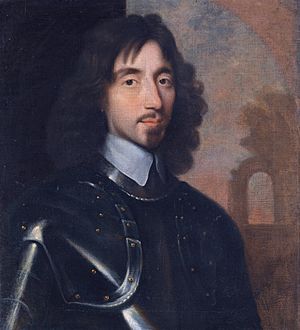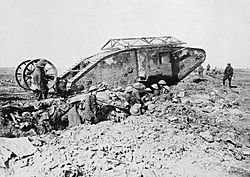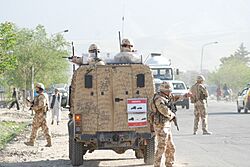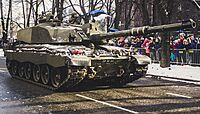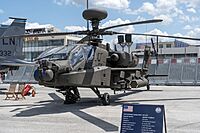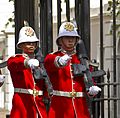British Army facts for kids
Quick facts for kids British Army |
|
|---|---|
 Badge of the British Army  Logo since 2018 |
|
| Founded | 1 April 1707 |
| Country | |
| Type | Army |
| Role | Land warfare |
| Size |
|
| Part of | |
| General Staff Offices | Whitehall, London |
| March | List of marches of the British Army |
| Equipment | List of equipment of the British Army |
| Commanders | |
| Head of the Armed Forces | |
| Chief of the General Staff | |
| Deputy Chief of the General Staff | Lieutenant General David Eastman |
| Assistant Chief of the General Staff | Major General Paul Griffiths |
| Army Sergeant Major | |
| Insignia | |
| War flag | |
| Non-ceremonial flag | |
The British Army is the main land-based fighting force of the United Kingdom. It is part of the British Armed Forces, along with the Royal Navy and the Royal Air Force. The army's job is to protect the UK and its interests around the world.
As of early 2025, the British Army had about 74,000 full-time soldiers, called regulars. It also included over 4,000 Gurkhas, nearly 26,000 part-time soldiers in the Army Reserve, and other staff. In total, there were over 108,000 people in the army.
The modern British Army was formed in 1707 when the Kingdoms of England and Scotland joined to create Great Britain. Before this, England and Scotland had their own separate armies. All soldiers in the British Army promise to be loyal to the monarch, who is the official head of the armed forces.
The army has fought in many major conflicts, including the Napoleonic Wars, World War I, and World War II. These wars helped Britain become a leading power in the world. Today, the army takes part in peacekeeping missions and works with other countries to keep people safe.
History of the British Army
How the Army Began
For a long time, England and Scotland did not have a permanent, professional army. When a war started, they used local militias or hired soldiers from other countries.
This changed during the Wars of the Three Kingdoms in the 1600s. The English Parliament realised it needed a better army to win. They created the New Model Army, a full-time, professional fighting force. It was well-trained, well-paid, and very successful.
After the monarchy was restored in 1660, the New Model Army was disbanded. However, King Charles II created a new, smaller standing army. This became the foundation of the English Army. After the Acts of Union 1707 joined England and Scotland, their armies merged to become the British Army.
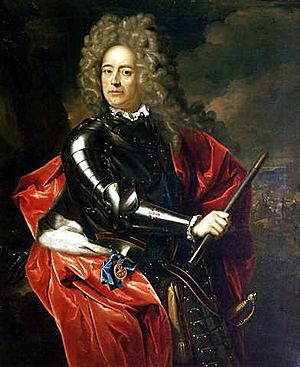
Building the British Empire (1707–1914)
After 1707, the British Army played a key role in the growth of the British Empire. Soldiers were sent to colonies in the Americas, Africa, Asia, and Australia. They helped capture important places and keep the empire secure.
The army fought in many wars during this time. These included the Seven Years' War, the American Revolutionary War, and the Napoleonic Wars. Victories in these conflicts made Britain a global power. The army also fought in China, New Zealand, India, and South Africa.
During the Napoleonic Wars, the British Army fought across Europe, the Caribbean, and North America. At its largest in 1813, the army had over 250,000 soldiers. The wars ended in 1815 when a force of British, Dutch, and Prussian soldiers defeated Napoleon at the Battle of Waterloo.
In the late 19th century, the army went through major changes called the Cardwell and Childers Reforms. These reforms modernised the army and created the regimental system that is still used today.
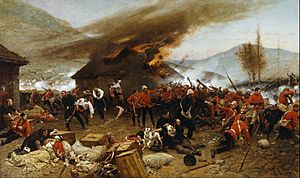
The World Wars (1914–1945)
The 20th century brought two world wars. In World War I (1914–1918), Britain sent the British Expeditionary Force (BEF) to France and Belgium. Much of the fighting took place in trenches, which was a slow and brutal type of warfare. The war was devastating, with millions of soldiers killed or wounded. New technologies like the tank and military aircraft changed how wars were fought.
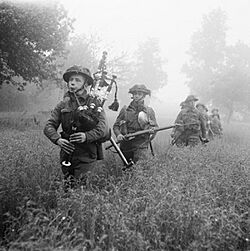
World War II began in 1939. The British Army again sent a BEF to France, but they had to be rescued from Dunkirk in 1940. After this, the army regrouped.
British soldiers fought in North Africa, Italy, and the Far East. In 1944, the army played a huge part in the D-Day landings in France. This was a turning point in the war in Europe. The war ended in 1945 after the defeat of Nazi Germany and Japan.
After the Wars (1945–2000)
After World War II, the British Empire began to change. Many colonies in Africa and Asia became independent countries. The army's size was reduced, but it remained active around the world.
The army served in conflicts in Korea, Cyprus, and Malaya. It also had a large force in Germany, called the British Army of the Rhine, to help protect Europe during the Cold War.
From 1969 to 2007, the army was deployed in Northern Ireland during a period known as the Troubles. This was the longest continuous operation in the army's history. Soldiers were there to support the police and keep the peace.
In 1982, the army helped to free the Falkland Islands after they were invaded by Argentina. In 1991, it joined a coalition of countries in the Gulf War to free Kuwait from Iraqi forces.
The Modern Army (2000–Present)
In the 21st century, the British Army has been involved in major operations in Afghanistan and Iraq.
War in Afghanistan
From 2001 to 2021, British forces were in Afghanistan. They worked with the United States and other allies to fight the Taliban. At its peak, there were about 9,500 British troops in the country, mainly in Helmand Province. The main combat mission ended in 2014, and all troops left by August 2021.
Iraq War
In 2003, the UK took part in the invasion of Iraq. The British Army was in charge of southern Iraq, helping to keep peace. Most troops were withdrawn by 2009. Since 2014, a smaller number of soldiers have been in Iraq to help train local forces against the terrorist group ISIL.
The Army Today
Structure and Command
The British Army is organised into different parts. The main headquarters is in Andover, Hampshire. The overall commander is the Chief of the General Staff.
The army is divided into two main commands:
- Field Army: This command prepares soldiers for operations and missions. It includes the main fighting units, like armoured, infantry, and aviation brigades.
- Home Command: This command handles recruiting, training, and support for the army in the UK.
The army also contributes to the United Kingdom Special Forces, which includes the famous Special Air Service (SAS).
Equipment
British soldiers use modern weapons and vehicles to do their jobs.
- Weapons: The standard rifle is the L85A3. Soldiers also use machine guns, sniper rifles, and anti-tank missiles like the Javelin.
- Armour: The main battle tank is the Challenger 2, which is being upgraded to the Challenger 3. Other armoured vehicles include the Warrior and the new Boxer.
- Artillery: The army uses powerful rocket systems like the MLRS and large guns like the Archer to support troops from a distance.
- Aviation: The Army Air Corps flies helicopters. The main attack helicopter is the Boeing AH-64E Apache. They also use Wildcat helicopters for finding information.
Ranks and Uniforms
The army has a clear rank structure, from Private (the most junior rank) up to General. Officers and soldiers wear different uniforms depending on what they are doing.
The daily combat uniform is called PCS-CU and uses a Multi-Terrain Pattern (MTP) camouflage. For parades and formal events, soldiers wear special ceremonial uniforms, like the famous red tunics and bearskin hats worn by the Guards at Buckingham Palace.
Most soldiers wear a beret. The colour of the beret shows which regiment or corps they belong to. For example, the Parachute Regiment wears a maroon beret, and the Royal Tank Regiment wears a black one.
Joining the Army
The British Army is a volunteer force. People can join as a full-time Regular soldier or a part-time Army Reservist.
To join the Regular Army, you must be at least 16 years old. Applicants from Commonwealth countries can also join. Everyone who joins must pass medical and fitness tests.
New recruits go through basic training to learn essential soldiering skills. After that, they get specialised training for their specific job, whether it's as an infantry soldier, an engineer, a medic, or a pilot.
All soldiers must take an oath of allegiance. In this oath, they promise to be faithful to the King and to obey orders.
Images for kids
-
The Blues and Royals at Trooping the Colour in 2013.
-
A Royal Bermuda Regiment soldier with an L85A2 rifle in 2018.
-
John Fitzgerald Kennedy inspects a Bermuda Rifles guard in 1961.
See also
 In Spanish: Ejército Británico para niños
In Spanish: Ejército Británico para niños





